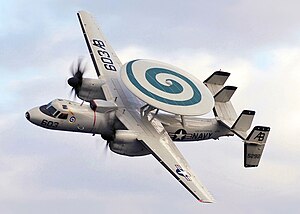Northrop Grumman E-2 Hawkeye
| E-2 Hawkeye | |
|---|---|
 |
|
| An E-2C Hawkeye from VAW-123 squadron performs a fly-by over USS Enterprise | |
| Role | Airborne early warning and control |
| National origin | United States |
| Manufacturer |
Grumman Northrop Grumman |
| First flight | 21 October 1960 |
| Introduction | January 1964 |
| Status | In service |
| Primary users |
United States Navy (See operators below) |
| Produced | 1960–present |
| Unit cost |
US$176 million (FY2012 flyaway cost)
|
| Developed into | Grumman C-2 Greyhound |
The Northrop Grumman E-2 Hawkeye is an American all-weather, carrier-capable tactical airborne early warning (AEW) aircraft. This twin-turboprop aircraft was designed and developed during the late 1950s and early 1960s by the Grumman Aircraft Company for the United States Navy as a replacement for the earlier, piston-engined E-1 Tracer, which was rapidly becoming obsolete. The aircraft's performance has been upgraded with the E-2B, and E-2C versions, where most of the changes were made to the radar and radio communications due to advances in electronic integrated circuits and other electronics. The fourth major version of the Hawkeye is the E-2D, which first flew in 2007. The E-2 was the first aircraft designed specifically for its role, as opposed to a modification of an existing airframe, such as the Boeing E-3 Sentry. Variants of the Hawkeye have been in continuous production since 1960, giving it the longest production run of any carrier-based aircraft.
The E-2 also received the nickname "Super Fudd" because it replaced the E-1 Tracer "Willy Fudd". In recent decades, the E-2 has been commonly referred to as the "Hummer" because of the distinctive sounds of its turboprop engines, quite unlike that of turbojet and turbofan jet engines. In addition to U.S. Navy service, smaller numbers of E-2s have been sold to the armed forces of Egypt, France, Israel, Japan, Mexico, Singapore and Taiwan.
Continual improvements in airborne radars through 1956 led to the construction of AEW airplanes by several different countries and several different armed forces. The functions of command and control and sea & air surveillance were also added. The first carrier-based aircraft to perform these missions for the U.S. Navy and its allies was the Douglas AD Skyraider, which was replaced in US Navy service by the Grumman E-1 Tracer, which was a modified version of the S-2 Tracker twin-engine anti-submarine warfare aircraft, where the radar was carried in an aerofoil-shaped radome carried above the aircraft's fuselage.
...
Wikipedia
